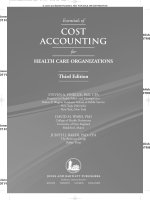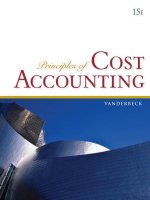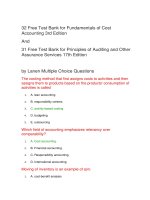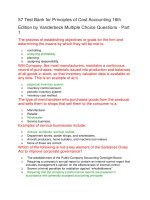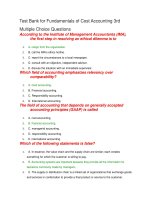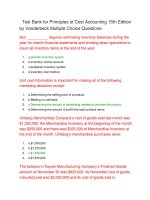Principles of cost accounting 15e vandebeck
Bạn đang xem bản rút gọn của tài liệu. Xem và tải ngay bản đầy đủ của tài liệu tại đây (4.8 MB, 569 trang )
PRINCIPLES
OF
COST
ACCOUNTING
This page intentionally left blank
PRINCIPLES
OF
COST
ACCOUNTING
15E
E D W A R D J. V A N D E R B E C K
Professor Emeritus
Department of Accountancy
Xavier University
Principles of Cost Accounting, 15th Edition
Edward J. VanDerbeck
Vice President of Editorial, Business: Jack W. Calhoun
Acquisitions Editor: Matt Filimonov
Developmental Editor: Lauren Athmer
Marketing Manager: Kristen Hurd
Marketing Coordinator: Heather McAuliffe
ª 2010, 2008 South-Western, Cengage Learning
ALL RIGHTS RESERVED. No part of this work covered by the copyright herein may be reproduced, transmitted, stored or used in any
form or by any means graphic, electronic, or mechanical, including but
not limited to photocopying, recording, scanning, digitizing, taping,
Web distribution, information networks, or information storage and
retrieval systems, except as permitted under Section 107 or 108 of the
1976 United States Copyright Act, without the prior written permission
of the publisher.
Content Project Manager: Corey Geissler
Production Technology Analyst: Starratt Alexander
Media Editor: Scott Fidler
Sr. Manufacturing Coordinator: Doug Wilke
For product information and technology assistance, contact us at
Cengage Learning Customer & Sales Support, 1-800-354-9706
For permission to use material from this text or product, submit all
requests online at www.cengage.com/permissions
Production Service: Cadmus
Sr. Art Director: Stacy Shirley
Further permissions questions can be emailed to
Internal Designer: Jennifer Lambert, Jen2Design, LLC
Cover Designer: cmiller design
Cover Image: ªGetty Images
Library of Congress Control Number: 2009935270
ISBN-10: 0-8400-3703-1
ISBN-13: 978-0-8400-3703-9
South-Western Cengage Learning,
5191 Natorp Boulevard
Mason OH 45040,
USA
Cengage Learning products are represented in Canada by Nelson
Education, Ltd.
For your course and learning solutions, visit www.cengage.com
Purchase any of our products at your local college store or at our
preferred online store www.ichapters.com
Printed in the United States of America
1 2 3 4 5 6 7 13 12 11 10 09
PREFACE
Why Study Cost Accounting?
The 15th edition of Principles of Cost Accounting, in an easily accessible
presentation, applies cost concepts, cost behavior, and cost accounting
techniques to manufacturing, merchandising, and service businesses. Students learn how to determine costs of products and services more accurately; use the knowledge of product and service costs to set selling prices,
to bid on contracts, and to analyze the relative profitability of various
products and services; use techniques to measure the performance of
managers and subunits within an organization; design an accounting system
to fit the production and distribution system of an organization; and use the
accounting system as a tool to motivate managers towards the organization’s goals.
What Does the 15th Edition Offer?
. Appropriate content for a one-quarter or one-semester cost accounting
course.
. A ten-chapter format—a distinguishing feature of the text that makes it
most appropriate for shorter courses.
. Directed assignments at intervals within each chapter.
. A very readable and relevant text that covers the essentials of cost
accounting in a logical sequence and concise manner.
. The inclusion of cost accounting techniques for service businesses.
. A discussion of the special purpose reports and analytical techniques
used for management decision making.
. Emphasis on nonfinancial performance measures via the balanced
scorecard.
. An increase in the number of end-of-chapter exercises, problems, and
Self-Study Problems.
vi
Principles of Cost Accounting
What Is New in the 15th Edition?
The 15th edition includes the following changes:
. All new chapter-opening vignettes with real-world applications.
. Increased use of graphics, including Excel spreadsheet ‘‘screen shots’’
and flow diagrams.
. An increase in the number of end-of-chapter self-study problems.
. An increased emphasis on ethical decision making in the end-of-chapter
Mini-Cases.
. Newly added ‘‘real company’’ examples throughout the text.
. First-time inclusion of corporate governance, lean manufacturing, demand software, and Web-based budgeting.
. An integrated illustration of materials control procedures.
. An illustration of the least squares regression method using Microsoft
Excel.
What Are the Features of the 15th Edition?
The 15th edition includes several features that facilitate the learning
process for the student and allow the instructor to teach with ease.
Directed Assignments
At specific points within each chapter, students are directed to appropriate
end-of-chapter assignments. This allows students to work practice items
without completing the entire chapter.
Self-Study Problems
Two demonstration problems are included at the end of each chapter, with
a step-by-step explanation of how to solve them. These Self-Study Problems are constructed from difficult concepts in the chapter and reinforce
the techniques and procedures discussed in the chapter. An added feature is
end-of-chapter problems that reference students back to Self-Study Problems that are similar in topic and difficulty.
End-of-Chapter Materials
The end-of-chapter questions, exercises, problems, mini-cases, and Internet
activities have been carefully written, revised, added to, and verified to
reflect the coverage as it appears in the chapters. There has been a
concerted effort to provide the instructor with a wide choice of subject
matter and degree of difficulty when assigning end-of-chapter materials.
Where appropriate, comprehensive review problems have been added that
cover concepts from more than one chapter. Additionally, selected problems may be solved using spreadsheet software.
Preface
Integrated Learning Objectives
Learning objectives begin each chapter. Each learning objective is indicated
in the text where first discussed. All end-of-chapter exercises, problems,
mini-cases, and Internet activities are identified by learning objectives.
Key Terms
Key terms are highlighted as they are introduced. They are listed, along
with page references, at the end of each chapter. A comprehensive glossary
is included at the end of the book, providing definitions for all the key
terms. Actual companies are highlighted where their practices are discussed
in the chapters.
Appendixes
The Institute of Management Accountants ‘‘Statement of Ethical Professional Practice’’ is included in an appendix at the end of Chapter 1. An
appendix at the end of Chapter 9 illustrates the four-variance and threevariance methods of analyzing factory overhead.
What Supplementary Materials Are Available?
A complete package of supplementary materials is available with the 15th
edition of Principles of Cost Accounting to assist both instructors and students.
The package includes materials that have been carefully prepared and
reviewed.
Available to Instructors
All instructor resources are available online on the Instructor Companion Web Site (www.cengage.com/accounting/vanderbeck), as well as
on the Instructor Resource CD-ROM (IRCD).
Solutions Manual. This manual contains the answers to all end-of-chapter
questions, exercises, problems, Internet exercises, and mini-cases.
Test Bank. The test bank is available in a computerized version for
Windows. The user may select, mix, edit, and add questions or problems to
create the type of test or problem set needed.
ExamView ProTM Testing Software. The printed test bank is available in a
computerized version for Windows. The user may select, mix, edit, and add
questions or problems to create the type of test or problem set needed.
ExamView is available on the Instructor’s Resource CD.
PowerPoint Presentations. This resource provides presentations for each
chapter, created specifically for this edition; thus, they follow along closely
vii
viii
Principles of Cost Accounting
with the text. The presentations for each chapter are also available online
for students to use as an additional study resource.
Instructor Resource CD-ROM (IRCD). This convenient resource includes
the Test Bank, ExamView, the Solutions Manual, PowerPoint Presentations, and the Instructor Spreadsheet Templates (with solutions).
Instructor Spreadsheet Templates. The Instructor Spreadsheet Templates
show the completed spreadsheet solutions for exercises within the end-ofchapter materials. These files are available on the IRCD, or they can be
downloaded from the Instructor Companion Web Site.
Instructor Companion Web Site (www.cengage.com/accounting/vanderbeck). The text-specific Web site provides access to all instructor resources
organized by chapter and topic, and are password protected. All of these
resources are also available on the IRCD: Test Bank, ExamView, Solutions
Manual, PowerPoint Presentations, and the Instructor Spreadsheet Templates (with solutions).
Available to Students
All student resources are available online on the Student Companion
Web Site (www.cengage.com/accounting/vanderbeck).
Study Guide. The study guide provides a review summary for each chapter
as well as questions and problems to test comprehension of chapter
material. Solutions for all questions and problems are included in a separate
section at the end of the study guide.
Student Spreadsheet Templates. The Student Spreadsheet Templates
correlate to exercises within the end-of-chapter materials. These files are
available for downloading on the Student Companion Web Site.
PowerPoint Presentations. This study resource provides presentations for
each chapter, created specifically for this edition; thus, they follow along
closely with the text.
Experience Accounting Videos. Highlight progressive companies and allow
you to effectively visualize critical chapter concepts—enhancing what you
learn in class! The Experience Accounting Videos can be bundled at no
additional cost with new copies of the text or can be purchased separately. You
can access the videos at www.cengage.com/accounting/eav.
Preface
Acknowledgments
We would like to thank all of those individuals who have helped during the
revision of this text by providing constructive comments and suggestions.
Josephine M. Mathias
Mercer County Community College
Joanne E. Shurbert
Concord’s Community College and Manchester Community College
Ann Bikofsky
College of West Chester
Theresa Laws-Dahl
Blackhawk Technical College
Sam Lester
Middle Georgia Technical College
Edward Kufuor
ASA Institute
Jim Murray
Western Technical College
David A. Flannery
Bryant & Stratton College, Virginia Beach
James Emig
Villanova University
ix
This page intentionally left blank
ABOUT THE AUTHOR
Ed VanDerbeck has been a professor of accounting for 32 years and was
Chair of the Department of Accountancy at Xavier University, Cincinnati,
Ohio, for 24 years. Before retiring in 2008, Professor VanDerbeck specialized in teaching cost accounting to accounting majors and managerial
accounting to undergraduate and MBA students. He has taught at the
two-year college level at SUNY–Delhi. He has a BA in Accounting from
Binghamton University (formerly SUNY–Binghamton) and an MS in
Business Administration from the University of Albany (formerly SUNY–
Albany). He is licensed as a CPA (inactive) in the state of Ohio. Professor
VanDerbeck has worked as an internal revenue agent, performed a
faculty internship at what was formerly the Big Eight accounting firm of
Touche-Ross. He has served as a developmental editor and marketing
manager for accounting publications with South-Western College Publishing. Professor VanDerbeck is an avid tennis player and a student of casino
gaming strategies.
This page intentionally left blank
BRIEF CONTENTS
Chapter 1
Introduction to Cost Accounting 1
Chapter 2
Accounting for Materials 63
Chapter 3
Accounting for Labor 123
Chapter 4
Accounting for Factory Overhead 169
Chapter 5
Process Cost Accounting—General Procedures 237
Chapter 6
Process Cost Accounting—Additional Procedures;
Accounting for Joint Products and By-Products 287
Chapter 7
The Master Budget and Flexible Budgeting 337
Chapter 8
Standard Cost Accounting—Materials, Labor, and
Factory Overhead 379
Chapter 9
Cost Accounting for Service Businesses and the
Balanced Scorecard 447
Chapter 10
Cost Analysis for Management Decision Making 481
Glossary
531
Index
543
This page intentionally left blank
CONTENTS
1
Introduction to Cost Accounting 1
Uses of Cost Accounting Information 4
Determining Product Costs and Pricing, Planning and Control
Professional Ethics, CMA Certification, and Corporate Governance 9
Relationship of Cost Accounting to Financial and Management Accounting 10
Costs of Goods Sold, Inventories
Elements of Manufacturing Costs 15
Direct Materials, Direct Labor, Factory Overhead, Summary of Manufacturing Costs,
Flow of Costs
Illustration of Accounting for Manufacturing Costs 18
Cost Accounting Systems 27
Special Order, Continuous or Mass Production, Combination of Systems, Standard Costing
Illustration of a Job Order Cost System 30
Work in Process in the Manufacturing Statement
IMA Statement of Ethical Professional Practice 36
Principles, Standards, Resolution of Ethical Conflict
2
Accounting for Materials 63
Materials Control 64
Physical Control of Materials, Controlling the Investment in Materials
Materials Control Procedures 70
Materials Control Personnel, Control during Procurement, Control during Storage and
Issuance
Accounting for Materials 79
Determining the Cost of Materials Issued, Accounting Procedures
Just-in-Time Materials Control 91
JIT and Cost Control, JIT and Cost Flows
Scrap, Spoiled Goods, and Defective Work 97
Scrap Materials, Spoiled and Defective Work
xvi
Principles of Cost Accounting
3
Accounting for Labor
123
Wage Plans 125
Hourly Rate Plan, Piece-Rate Plan, Modified Wage Plans
Controlling Labor Cost 128
Labor Time Records, Payroll Function
Accounting for Labor Costs and Employers’ Payroll Taxes 132
Employers’ Payroll Taxes, Illustration of Accounting for Labor Costs
Payroll Accrual 141
Special Labor Cost Problems 144
Shift Premium, Employee Pension Costs, Bonuses, Vacation and Holiday Pay, Accounting
for Bonuses, Vacations, and Holiday Pay
4
Accounting for Factory Overhead
169
Identifying Cost Behavior Patterns 170
Analyzing Semivariable Factory Overhead Costs 172
Observation Method, High-Low Method, Scattergraph Method, Limitations of High-Low
and Statistical Scattergraph Methods, Least-Squares Regression Method
Budgeting Factory Overhead Costs 179
Accounting for Actual Factory Overhead 180
Factory Overhead Analysis Spreadsheets, Schedule of Fixed Costs, General Factory
Overhead Expenses, Summary of Factory Overhead
Distributing Service Department Expenses 185
Applying Factory Overhead to Production 192
Direct Labor Cost Method, Direct Labor Hour Method, Machine Hour Method,
Activity-based Costing Method
Accounting for Actual and Applied Factory Overhead 198
5
Process Cost Accounting—General Procedures
237
Comparison of Basic Cost Systems 238
Materials and Labor Costs, Factory Overhead Costs
Product Cost in a Process Cost System 239
Nondepartmentalized Factory, Departmentalized Factory
Work in Process Inventories 240
Cost of Production Summary—One Department, No Beginning Inventory 244
Cost of Production Summary—One Department, Beginning Inventory 247
Cost of Production Summary—Multiple Departments, No Beginning Inventory 250
Cost of Production Summary—Multiple Departments, Beginning Inventory 259
Changes in Prior Department’s Unit Transfer Costs 266
Contents
6
xvii
Process Cost Accounting—Additional Procedures;
Accounting for Joint Products and By-Products 287
Equivalent Production—Materials Not Uniformly Applied 288
Illustrative Problem No. 1, Illustrative Problem No. 2, Illustrative Problem No. 3
Units Lost in Production 296
Units Gained in Production 298
Equivalent Production—First-In, First-Out Method 299
Illustrative Problem No. 1, Illustrative Problem No. 2
Joint Products and By-Products 309
Accounting for Joint Products, Accounting for By-Products
7
The Master Budget and Flexible Budgeting
337
Principles of Budgeting 338
Preparing the Master Budget 338
Sales Budget, Production Budget, Direct Materials Budget, Direct Labor Budget,
Factory Overhead Budget, Cost of Goods Sold Budget, Selling and Administrative Expenses
Budget, Budgeted Income Statement, Other Budgets, Evaluating Budget Performance
Flexible Budgeting 350
Preparing the Flexible Budget, Preparing a Performance Report Based on Flexible
Budgeting
Preparing the Flexible Budget for Factory Overhead 355
Using the Flexible Budget, Semifixed and Semivariable Costs, Service Department Budgets
and Variances, Summary of the Budgeting Process
8
Standard Cost Accounting—Materials, Labor, and
Factory Overhead 379
Types of Standards 381
Standard Cost Procedures 381
Determination of Standard Costs for Materials and Labor, Recording Standard Costs for
Materials and Labor
Determination of Variances 384
Alternative Method of Recording Materials Cost
Accounting for Variances 389
Alternative Method of Recording Materials Cost, Disposition of Standard Cost Variances
Interpreting Variances 392
Features of Standard Cost Accounting 397
Illustration of Standard Cost in a Departmentalized Factory 398
Analysis of Factory Overhead Standard Cost Variances 405
Two-Variance Method of Analysis 406
Four-Variance and Three-Variance Methods of Analysis 412
Four-Variance Method of Analysis 412
Three-Variance Method of Analysis 414
xviii
Principles of Cost Accounting
9
Cost Accounting for Service Businesses and the
Balanced Scorecard 447
Job Order Costing for Service Businesses 448
Job Cost Sheet for a Service Business, Choosing the Cost Allocation Base, Tracing Direct
Costs to the Job, Cost Performance Report
Budgeting for Service Businesses 451
The Revenue Budget, The Labor Budget, The Overhead Budget, The Other Direct
Expenses Budget, The Budgeted Income Statement
Activity-Based Costing in a Service Firm 455
Converting Indirect Costs to Direct Costs, Multiple Indirect Cost Pools, Job Cost Sheet—
Activity-Based Costing
Allocations Using Simplified Costing Versus Activity-Based Costing 459
The Balanced Scorecard 463
The Four Categories of a Balanced Scorecard, Guidelines for a Good Balanced Scorecard,
The Balanced Scorecard Illustrated
10
Cost Analysis for Management Decision Making
481
Variable Costing and Absorption Costing 482
Product Costs Versus Period Costs, Illustration of Variable and Absorption Costing
Methods
Merits and Limitations of Variable Costing 486
Segment Reporting for Profitability Analysis 488
Cost-Volume-Profit Analysis 491
Break-even Analysis, Break-even Chart, Break-even Analysis for Management Decisions,
Effect of Sales Mix on Break-even Analysis
Contribution Margin Ratio and Margin of Safety 499
Effect of Income Tax on Break-even Point and Net Income 501
Differential Analysis 502
Accept or Reject a Special Order, Make or Buy
Distribution Costs 505
Glossary 531
Index 543
PRINCIPLES
OF
COST
ACCOUNTING
This page intentionally left blank
CHAPTER 1
Learning Objectives
I n t r o d u ct i o n t o C o s t
Accounting
After studying this
chapter, you should
be able to:
Explain the
uses of cost
accounting information.
LO1
Describe the
ethical responsibilities and certification requirements
for management
accountants, as well
as corporate
governance.
LO2
An article in the August 22, 2008 Wall Street Journal, ‘‘Burger
King Battles Costs with Small Whopper Jr.,’’ describes Burger
King’s attempt to ‘‘overcome high ingredient costs that are
eating into its profit.’’ Chief Executive John Chidsey said, ‘‘To
combat costs, Burger King is testing its $1 Whopper Jr. with
smaller hamburger pattie—down to two ounces apiece from 2.2
ounces—in some markets and experimenting with different
beverage sizes.’’ The article went on to explain that ‘‘McDonald’s
is testing modifications to its $1 double cheeseburger, including
selling a different version and raising the price of the traditional
double cheeseburger.’’
. What is the total cost to make and sell each Whopper Jr. or
McDonald’s double cheeseburger?
. How many burgers must be sold and at what prices to cover
costs and to provide shareholders with an acceptable return
on their investment?
. Given that fast-food prices are constrained by competitors’
prices, what other cost-cutting measures might Burger King
employ to return operations to normal profit margins?
These questions can be best answered with the aid of cost
information introduced in this and the following chapters.
Describe the
relationship
of cost accounting to
financial and management accounting.
LO3
Identify the
three basic
elements of manufacturing costs.
LO4
Illustrate
basic cost
accounting procedures.
LO5
Distinguish
between the
two basic types of cost
accounting systems.
LO6
LO7
T
he importance of cost accounting information to the successful
operation of a business has long been recognized. However, in the
current global economic environment, such information is more
system.
Illustrate a job
order cost
2
Principles of Cost Accounting
Figure 1-1
Production Process for Goods and Services
Outputs
Inputs (factors of production)
Raw materials
Goods
Natural resources
Conversion process
Human resources
Capital
Services
crucial than ever. Automobiles from Korea, clothing from China, electronic
equipment from Japan, and laptop computers from Poland are just a few
examples of foreign-made products that have provided stiff competition to
U.S. manufacturers both at home and abroad. As a result of these pressures,
companies today are placing more emphasis on controlling costs in an
attempt to keep their products competitive. For example, U.S. companies
are outsourcing production and service activities to other countries, such as
production operations in Honduras and Indonesia and technical support
call centers in India.
Cost accounting provides the detailed cost information that management needs to control current operations and plan for the future. Figure 1-1
illustrates the production process for goods and services for which cost
accounting provides information. Management uses this information to
decide how to allocate resources to the most efficient and profitable areas of
the business.
All types of business entities—manufacturing, merchandising, and
service businesses—require cost accounting information systems to track
their activities. Manufacturers convert purchased raw materials into finished goods by using labor, technology, and facilities. Merchandisers
purchase finished goods for resale. They may be retailers, who sell
products to individuals for consumption, or wholesalers, who purchase
goods from manufacturers and sell to retailers. For-profit service businesses, such as health clubs, accounting firms, and NBA basketball teams,
sell services rather than products. Not-for-profit service agencies, such as
charities, governmental agencies, and some health care facilities, provide
services at little or no cost to the user.
The nature of the manufacturing process requires that the accounting
information systems of manufacturers be designed to accumulate detailed
cost data relating to the production process. It is common today for
manufacturers of all sizes to have cost accounting systems that track the
Chapter 1 – Introduction to Cost Accounting
costs incurred to produce and sell their diverse product lines. While the
cost accounting principles and procedures discussed in the text mostly
emphasize manufacturers, many of the same principles apply to merchandising and service businesses. Cost accounting is essential to the efficient
operation of fast-food restaurants, athletic teams, fine arts groups, hospitals,
social welfare agencies, and numerous other entities. Chapter 9 and various
other sections throughout the text illustrate cost accounting procedures for
service businesses.
In many ways, the activities of a manufacturer are similar to those of a
merchandiser. They purchase, store, and sell goods; both must have
efficient management and adequate sources of capital; and they may employ
hundreds or thousands of workers. The manufacturing process itself highlights the differences between the two: merchandisers, such as Target, buy
goods in marketable form to resell to their customers; manufacturers, such
as Procter & Gamble, must make the goods they sell. Once a merchandiser has acquired goods, it can perform the marketing function. The
purchase of raw materials by a manufacturer, however, is only the beginning of a long and sometimes complex chain of events that results in a
finished product for sale.
The manufacturing process requires the conversion of raw materials
into finished goods through the use of labor and various other factory
resources. A manufacturer must make a major investment in physical assets,
such as property, plant, and equipment. To produce finished goods, a
manufacturer must purchase appropriate quantities of raw materials and
supplies, and develop a workforce. In addition to the cost of materials and
labor, the manufacturer incurs other expenses in the production process.
Many of these costs, such as depreciation, taxes, insurance, and utilities, are
similar to those incurred by a merchandising concern. Costs such as
machine maintenance and repair, materials handling, production setup,
production scheduling, and inspection are unique to manufacturers. Other
costs, such as selling and administrative expenses, are similar to those
incurred by merchandisers and service businesses. The methods of accounting for sales, cost of goods sold, and selling and administrative expenses for
a manufacturer are similar to those of merchandisers. Service businesses, by
comparison, have no inventories because the service is consumed at the
time it is provided. Service businesses have revenue and operating expenses,
but no cost of goods sold.
Note that product quality is as important a competitive weapon as cost
control in the global arena. Originally issued for companies marketing
products in Europe, a set of international standards for quality management, known as the ISO 9000 family, was designed by the International
Organization for Standardization, based in Switzerland. The standards
require that manufacturers have a well-defined quality control system, that
they consistently maintain a high level of product quality to enhance
customer satisfaction, and that they achieve continual improvement of their
performance in pursuit of these objectives. The standards are accepted in
158 countries, 106 of which are ‘‘member bodies’’ with full voting rights on
3
4
Principles of Cost Accounting
technical and policy issues.1 Major U.S. companies such as General
Electric and Procter & Gamble require their suppliers to obtain ISO
9000 certification.
Uses of Cost Accounting Information
Explain the
uses of cost
accounting information.
LO1
Principles of cost accounting have been developed to enable manufacturers
to process the many different costs associated with manufacturing and to
provide built-in control features. The information produced by a cost
accounting system provides a basis for determining product costs and
selling prices, and it helps management to plan and control operations.
Determining Product Costs and Pricing
Cost accounting procedures provide the means to determine product costs
that enable the preparation of meaningful financial statements and other
reports needed to manage a business. The cost accounting information
system must be designed to permit the determination of unit costs as well
as total product costs. For example, the fact that a manufacturer spent
$100,000 for labor in a certain month is not, in itself, meaningful; but if
this labor produced 5,000 finished units, the fact that the cost of labor was
$20 per unit is significant. This figure can be compared to the company’s
unit labor cost for prior periods and, often, to the labor cost of major
competitors.
Unit cost information is also useful in making a variety of important
marketing decisions such as:
1. Determining the selling price of a product. Knowing the manufacturing
cost of a product aids in determining the desired selling price. It should
be high enough to cover the cost of producing the item and the
marketing and administrative expenses attributable to it, as well as to
provide a satisfactory profit to the owners.
2. Meeting competition. If a product is being undersold by a competitor,
detailed information regarding unit costs can be used to determine
whether the problem can be resolved by reducing the selling price, by
reducing manufacturing and selling expenses attributable to the product,
or by some combination of the above that will still result in profitable sales.
3. Bidding on contracts. Many manufacturers must submit competitive bids
in order to be awarded contracts. Knowledge of the unit costs attributable to a particular product is of great importance in determining the
bid price.
4. Analyzing profitability. Unit cost information enables management to
determine the amount of profit that each product earns, thereby allocating the company’s scarce resources to those that are most profitable.
1 International Organization for Standardization, ‘‘ISO Members,’’ www.iso.org.
